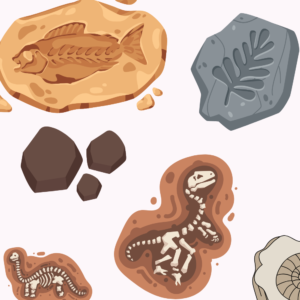
Patterns of Fossils and Rock Formations
1. Types of Rocks
- Igneous Rocks: Formed from cooled magma or lava.
- Sedimentary Rocks: Created from particles of sand, shells, pebbles, and other fragments of material. Most fossils are found in sedimentary rocks.
- Metamorphic Rocks: Formed under the surface of the Earth from the metamorphosis (change) of igneous or sedimentary rocks due to extreme pressure and heat.
2. Rock Cycle
- Overview: Describe the continuous process of rock transformation from one type to another.
- Processes Involved: Weathering, erosion, sedimentation, compaction, metamorphism, and melting.
- Diagram: Include a simplified diagram of the rock cycle to illustrate these processes.
3. Fossil Formation
- Conditions Required: Discuss the rare conditions required for fossilization, including rapid burial and the presence of sediments.
- Types of Fossils:
- Body Fossils: Bones, teeth, shells.
- Trace Fossils: Footprints, burrows, coprolites.
- Molecular Fossils: Chemical residues.
- Process of Fossilization: Explain permineralization, casts and molds, amber preservation, and carbonization.
4. Stratigraphy
- Definition: The study of rock layers (strata) and layer sequencing.
- Principles:
- Law of Superposition: Older layers are deeper than younger layers unless the sequence has been overturned or disturbed.
- Principle of Original Horizontality: Layers of sediment are originally deposited horizontally under the action of gravity.
- Principle of Cross-Cutting Relationships: Younger features cut across older features.
- Applications: How stratigraphy is used to date rocks and fossils.
5. Geological Time Scale
- Definition: A system of chronological dating that relates geological strata to time.
- Eras and Periods: Breakdown of major geological and biological events in Earth’s history.
- Significance: Importance in understanding the timing and sequence of events leading to the present-day Earth.
6. Case Studies
- Example 1: The Grand Canyon – Examine the stratigraphy exposed by the erosion and what it tells us about North American geological history.
- Example 2: The Burgess Shale – Discuss the preservation of Cambrian fossils and their impact on our understanding of early life.
7. Review and Reflect
- Key Points Recap: Summarize the main points from each section.
- Discussion Questions:
- How do fossils help scientists reconstruct the past?
- Why are most fossils found in sedimentary rocks?

